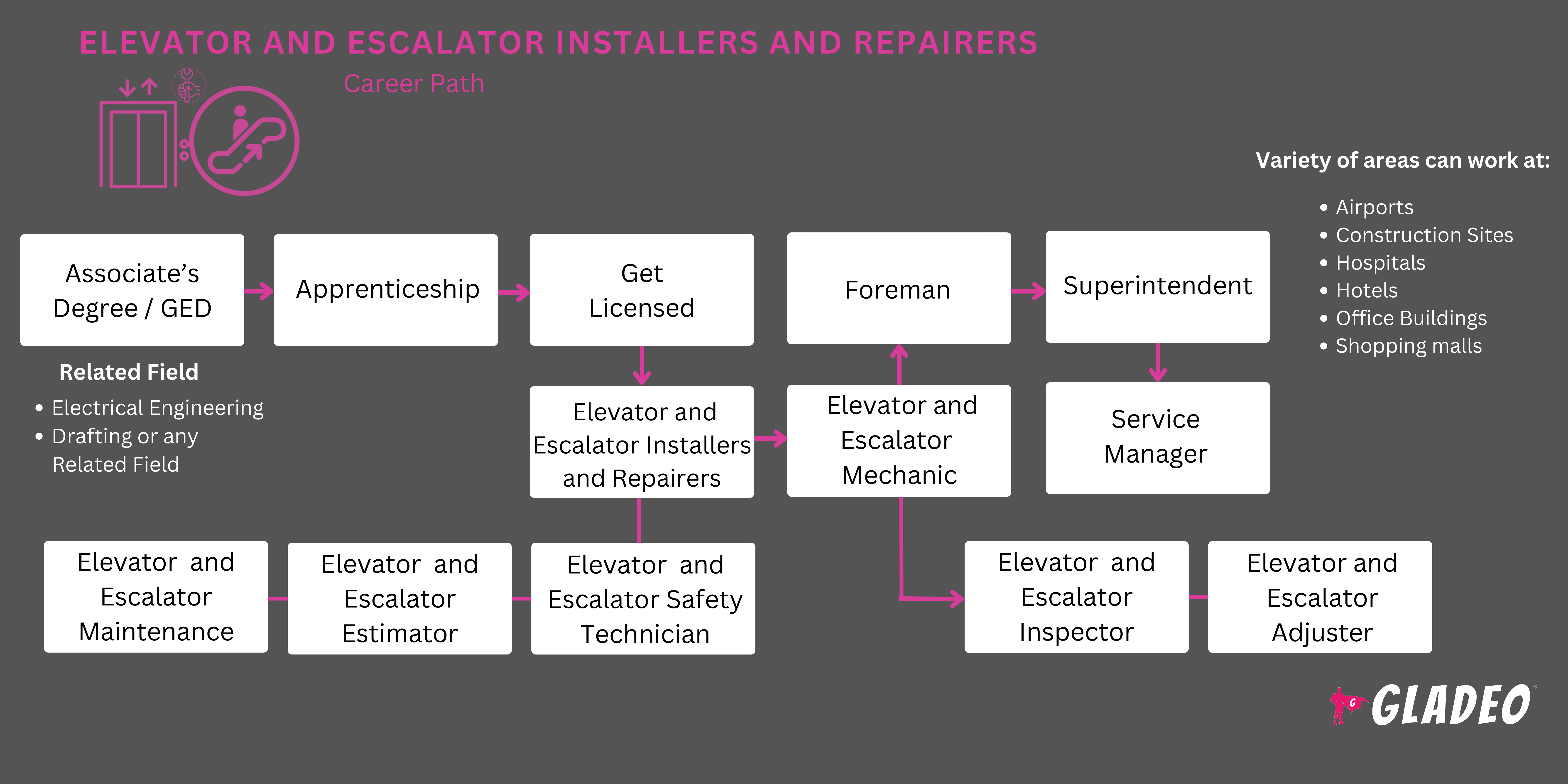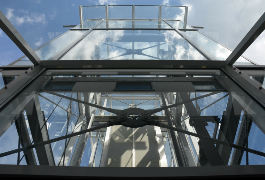스포트라이트
Elevator Adjuster, Elevator Constructor, Elevator Mechanic, Elevator Repair and Maintenance Technician, Elevator Service Mechanic, Elevator Service Technician, Elevator Serviceman, Elevator Technician, Elevator Troubleshooter, Escalator Service Mechanic
As you might have guessed, Elevator and Escalator Installers and Repairers put in new elevators and escalators in buildings, and then perform maintenance, troubleshooting, and repair work as needed. They can also install moving walkways like the ones in airports, as well as other types of lifts. These workers are experts when it comes to hydraulics, motors, the electrical components that power the equipment, and the computerized systems that control them.
For big jobs where elevator cables or bearings have to be swapped out, a crew might be called in to tackle the work as fast as possible. Many tall buildings rely heavily on their elevators working properly and safely, just as malls, subways, airports, and other heavily-trafficked hubs need their escalators up and running at all times. That’s why Elevator and Escalator Installers and Repairers are such critical players in today’s modern society, even if we don’t always see their hard work behind-the-scenes!
- Playing a crucial role in making sure all building floors are accessible to visitors, employees, or tenants
- Working in a field that helps physically challenged individuals who cannot use stairs
- Enabling the construction of high-rise buildings that could not exist without elevators
근무 일정
Elevator and Escalator Installers and Repairers work full-time with overtime potential during tight deadlines. They may also have to be on call for emergencies.
일반적인 의무
- Review blueprints of layouts
- Assess work to be done, to include all affected systems
- Build elevator cars; install escalators, moving walkways, chairlifts, and related equipment
- Install counterweights
- Bolt or weld rails to shaft interior walls
- Wire control panels and motors and test for proper functionality and power consumption
- Perform general troubleshooting steps to determine problem causes
- Fix or replace improperly working brakes, motors, switches, or other bad parts
- Ensure general maintenance is completed in a timely manner
- Disassemble equipment using various tools
추가 책임
- Maintain records/logs of all work accomplished
- Comply with all building, local, or state safety codes, as applicable
- Wear all personal protective equipment
- Respond to emergencies promptly, such as when a person is trapped inside an elevator
소프트 스킬
- Comfortable with heights
- Detail-focused
- 손과 눈의 협응
- 인내와 끈기
- 문제 해결
- 안전 지향
- Stamina and strength
기술 능력
- Elevator Controls
- 시설 관리 프로그램
- 블루프린트 읽기
- Mechanical skills such as tool usage, including tools like graphic records, pressure indicators, welding machines, voltage meters, blowtorches, circuit testers, conduit benders, hacksaws, hoists, levels, micrometers, multimeters, Ohmmeters, phasemeters, platform lifts, power drills, pull spring balances, soldering irons, slings, tachometers, tensiometers, two way radios, and many more
- General understanding of physics, math, building construction
- Building equipment contractors
- 교육 기관
- 정부 기관
Elevator and Escalator Installers and Repairers work hard to ensure the proper operation of powerful equipment that can be hazardous if not installed right or working correctly. In particular, elevators carry people to great heights, several stories into the air. Thus workers in these fields bear a tremendous responsibility to make sure equipment functions the way it is designed to, and to find and fix any issues before they become serious. They’re also expected to respond promptly when emergencies are reported.
Elevator and Escalator Installers and Repairers are predicted to stay in demand in the coming years, as more buildings are constructed and are being built taller than ever. Meanwhile there’s a wide push to increase accessibility for persons with physical limitations, which means areas that used to only have stairs may need additional access means installed, such as lifts. There is also thankfully more attention paid to safety issues within older buildings, to include ensuring that elevators are being fully maintained and repaired. When newer equipment is installed, it’s often more technologically advanced, which is why the Bureau of Labor Statistics expects new workers entering the field with some electronics education will be the most competitive in the job market.
Workers in this field likely always enjoyed rolling up their sleeves and getting their hands on some complicated project. They like big mechanical things, and may have a preference for indoor work versus being outside in the elements. Because elevators and escalators have many electrical controls aspects, installers and repairers probably studied electrical topics in school or maybe even on their own as a hobby. They are detail-oriented and precise, and take pride in ensuring their projects work the way they’re designed to!
- 시작하려면 고등학교 졸업장 또는 검정고시가 필요합니다.
- Any relevant practical work experience will be helpful to qualify
- Most Elevator and Escalator Installers and Repairers learn by a 4-year apprenticeship and On-The-Job training to include technical training
- Most states require licensure (currently 35 do and 15 don’t), and employers will likely expect workers to hold a valid, current driver's license so they can respond quickly, when needed
- 선택적 인증에는 다음이 포함됩니다.
- National Association of Elevator Contractors -
- Certified Elevator Technicians (CET)
- Certified Accessibility and Private Residence Lift Technicians (CAT)
- National Association of Elevator Safety Authorities International
- Qualified Elevator Inspectors (QEI)
- National Association of Elevator Contractors -
- According to O*Net, 40% of Elevator and Escalator Installers and Repairers start with only a high school diploma; 36% complete some college
- Good classes to take to get ahead include safety, math, blueprint reading, electronics, and, if available, courses that cover elevator and escalator parts
- Review the National Association of Elevator Contractors’ site to learn more about their apprenticeship prerequisites, and take classes that will help you qualify
- Look for programs that qualify for federal aid Pell Grant funds, if doing a FAFSA
- 프로그램 완료 후 취업 지원에 대한 정보를 검토하세요.
- Decide if you want to specialize in elevators or escalator installation
- Work part-time jobs that give you experience with relevant systems and handling the types of tools you’ll need to be qualified on
- Consider getting some hands-on tool experience through Habitat for Humanity
- Take pertinent classes such as math, blueprint reading, and electronics
- Get First Aid certified and learn about applicable safety protocols and building codes
- Look for training via the National Association of Elevator Contractors
- Talk to working Elevator and Escalator Installers and see what the job is really like from an insider! Ask how they got their apprenticeship, if they completed one
- Do some homework by watching tutorial videos and taking short non-college classes

- Search for local jobs on Indeed, Monster, Craigslist, and Glassdoor
- Complete as much practical work experience or as many academic courses as you can to qualify for apprenticeships
- Get certified on First Aid
- If applying for an apprenticeship, you may need to pass an aptitude test and submit a resume, so add all your relevant work and educational experiences and list tools you know how to use
- Find sample resumes online and tailor them to the apprenticeship or job postings you’re applying to
- Have a professional editor or English-skilled friend look over your application materials
- Learn the vocabulary of the trade and study real-life interview questions
- Become proficient in your duties and pay close attention during all OJT
- Demonstrate that you have integrity, are dependable, and have an aptitude for the work
- Take advanced courses if suitable for the position you have or the one you want
- Workers may have the chance to become mechanics or assistant mechanics. Ask your employer about specific career growth opportunities in advance and let them know you want to qualify for those, but first master the skills and tools of your current job
- Show that you can work on your own without supervision
- Complete certifications, such as:
- National Association of Elevator Contractors -
- Certified Elevator Technicians (CET)
- Certified Accessibility and Private Residence Lift Technicians (CAT)
- National Association of Elevator Safety Authorities International
- Qualified Elevator Inspectors (QEI)
- Finish your apprenticeship and become a journeyman
- National Association of Elevator Contractors -
Elevator and Escalator Installers and Repairers have a solid job outlook, but that doesn’t mean you can’t look into other options. A few alternative careers are cited on BLS’s related occupations, including:
- 보일러 메이커
- 전기 및 전자 설치자 및 수리업체
- 전기
- 산업 기계 기계공, 기계 유지 보수 노동자 및 밀라이트
- 철공 노동자
- 판금 노동자
- 풍력 터빈 기술자
뉴스 피드

주요 채용 정보

온라인 과정 및 도구

연봉 기대치
New workers start around $105K. Median pay is $139K per year. Highly experienced workers can earn around $142K.






